Prosecco vs Champagne: What’s the Difference? [Detailed Guide]
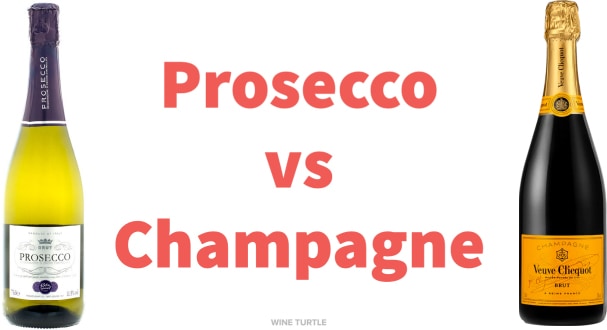
Prosecco and Champagne are easy to confuse when you are new to wine. They share certain similarities that may be hard to distinguish initially.
For starters, both are bottles of sparkling wine known as "bubbly," and both are drunk during celebrations.
However, they come from different countries, smell and taste different, and Champagne is a luxury while Prosecco is significantly cheaper.
Also, Prosecco was only introduced to the US in 2000 by Mionetto, while the Thirteen Colonies introduced Champagne in 1750.
This article covers everything you need to know about Prosecco and Champagne to help you understand the differences and pick the right tipple for your next celebration.
The Quick Answer: Prosecco vs Champagne
The key difference is Champagne originates from the Champagne region of France, while Prosecco originates from the Veneto region of Northern Italy.
They also use different grapes (Glera for Prosecco, Chardonnay for Champagne).
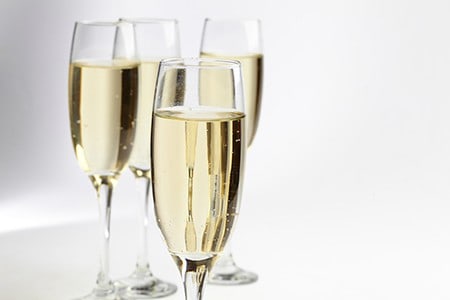
Here's a run-down of the other key differences:
Labeling Requirements
Only winemakers producing sparkling wines in the Champagne district in France can use the 'Champagne' name in their products.
The rules for Prosecco are nowhere near as strict.
In the US, sparkling wine labeled 'Prosecco' must use 85% Glera grapes from Italy (previously known as the Prosecco grape).
Providing Prosecco uses 85% Glera grapes it can use international grape varieties for the other 15%, including Chardonnay from France.
In the EU, Prosecco must use grapes originating from the provinces of Belluno, Gorizia, Padua, Pordenone, Treviso, Trieste, Udine, Venice, and Vicenza.
Overall, Champagne is the more tightly controlled wine, making it more expensive and prized.
This shows in production volumes, with 300 million bottles of Champagne produced globally versus 500 million for Prosecco.
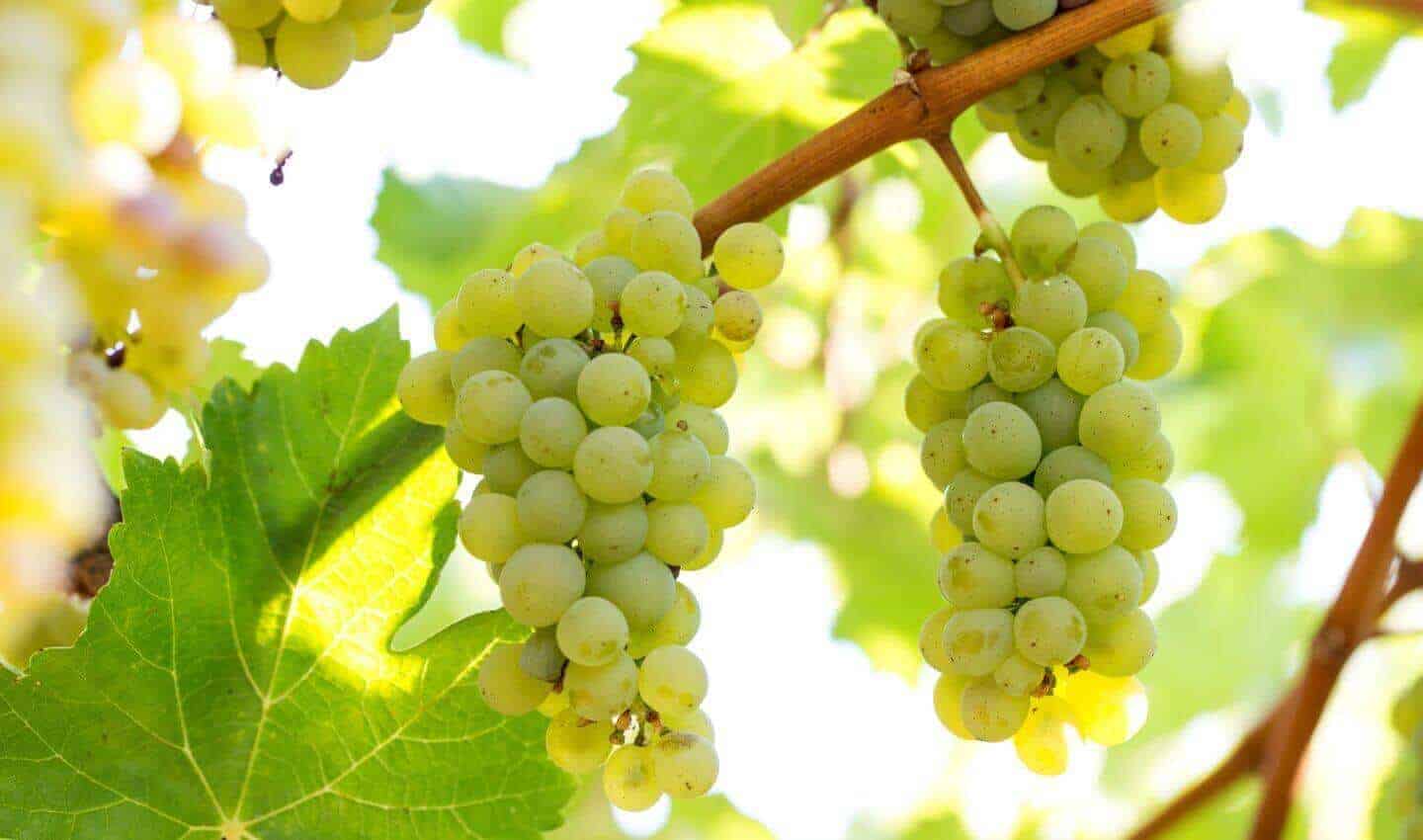
Grapes
Prosecco is made from at least 85% Glera grapes, while Champagne uses Chardonnay with Pinot Noir and Pinot Meunier.
We say 'usually' because you can also get 100% Chardonnay champagne, known as "Blanc de Blancs." This variety is often the most expensive.
You can also get 100% Glera Prosecco - it commands a higher price tag and is considered the purest expression of Italian sparkling wine.
Tasting Notes
Champagne and Prosecco have different taste profiles. Champagne is citrusy, almondy, peachy, and toasty, while Prosecco is appley, creamy, and sweet.
Even dry varieties of Prosecco taste sweeter than Champagne, and the fruitier notes give it a distinct taste against the bready and citrusy profile of Champagne.
The line is blurred as you move towards sweet champagnes, which can fool people into thinking they are Prosecco on a blind taste test.
Another important distinction is that Champagne has finer, more persistent bubbles than Prosecco, a by-product of a longer fermentation.
Additionally, while Champagne is always fizzy, Prosecco is available in flat (Tranquillo) and semi-fizzy (Frizzante) varieties.
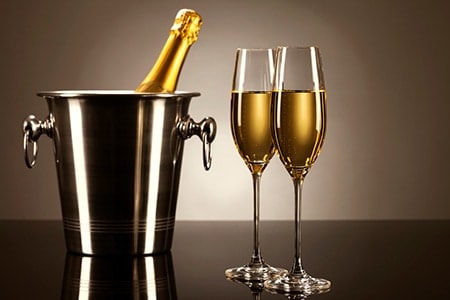
Sweetness Scale
Champagne and Prosecco share a sweetness scale:
- Brut Nature – bone dry - 0-3g/L sugar
- Extra Brut – dry - 0-6g/L sugar
- Brut – dry with a hint of sweetness – less than 12g/L sugar
Sweeter sparkling wines use this scale:
- Extra Dry – Noticeably sweet - 12-17g/L sugar
- Dry – very sweet, but not dessert sweet - 17-32g/L sugar
- Demi-Sec – sweet for desserts - 32-50g/L sugar
- Doux – sweet enough as a dessert itself – 50+g/L sugar
Confusingly, sparkling wines labeled as 'Extra Dry 'are sweeter than 'Brut'.
The label 'Extra Dry' clarifies greater sweetness and sugar, so it's important not to mix them up.
Less sugary sparkling wines are best with savory dishes, while sweeter wines are better with desserts. For cheeses, you want a Brut or Extra Brut.
The Detailed Answer: Prosecco vs Champagne
We've covered the differences between champagne and prosecco as concisely as possible in the previous section, but if you need the complete story then read on.
Background of Champagne
Champagne is great for celebrations and luxurious events, but where does it come from, and where does the story start?

Summary
Vineyards have grown in Champagne since the early 5th century, but the Chardonnay grapes in champagne wine have grown there since the 12th century.
The wine as we know it today was discovered by accident in the 15th century.
History
The Romans created the first recorded vineyards in Champagne at the end of the 4th/beginning of the 5th century.
In the 9th century, wines from this region were called Vins de la Montagne (wines of the mountain), highly prized for their quality, and consumed by royalty and the upper classes.
The production of still (non-sparkling) wine in Champagne dates back thousands of years, but the first sparkling version of champagne wine was accidental, produced as a twist of fate from a cold climate in the 1400s.
Because of cold winters, fermentation of the wine in cellars slowed down, making it awaken with haste in spring. Most bottles exploded because of carbonation, but some survived, creating a sparkling white wine.
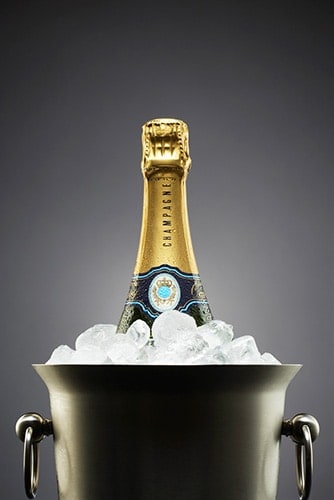
To say that this was considered the result of poor winemaking is an understatement; this fizzy, carbonated wine was an embarrassment for winemakers.
However, just as lobster meat was considered lesser at one time, sparkling white wine became a luxurious tipple over the next few decades.
Dom Pérignon invented a second fermentation process in 1668, which is necessary to produce Champagne as we know it today.
Another Pérignon innovation was a circular vertical press that gently pressed the grapes, preserving the wine's whiteness.
It wasn't until the late 17th century that the wine was popularized as "Champagne," and it wasn't until the 18th century that other countries imported it.
Champagne was popularized in 18th century England as an aristocratic drink out of the reach of commoners. It spread to cultured society over the next century, following imports of non-sparkling wine from the Champagne region in the 17th century.
Flash-forward to today, and about 300 million bottles of Champagne get produced each year -- not bad for a wine produced in one region of France!
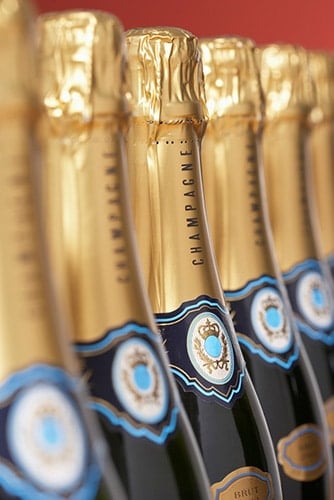
How it's made
Champagne gets its bubbles from a second fermentation that takes place in the bottle, but this is only one step in the production process:
Harvesting
The grapes for Champagne are harvested between August and October, picked by hand to ensure that the grapes are ripe.
Pressing
The grapes are pressed with a circular vertical press to release the grape juice without tainting it with the skins of the grapes.
First fermentation
The grape juice is poured into a fermentation tank to produce a still acidic wine, and natural sugars in the wine are eliminated.
Assemblage
Assemblage refers to blended wines and is only relevant to champagne wines with more than one type of grape (Chardonnay, Pinot Noir, Minot Meunier).
Second fermentation
Yeast and sugar are added to the wine, and the wine is poured into yeasting bottles, where it carbonates in a cool cellar for months.
Aging
After a few months, the second fermentation completes, but winemakers leave the bottles to age in the cellar for a few years to develop the flavor.
Riddling
Riddling refers to removing dead yeast. The bottles are turned upside down and agitated, so the yeast drops to the bottom.
Disgorging
Disgorging freezes the bottleneck in an ice-salt bath, forcing dead yeast to the bottom. The yeast is then removed.
Dosage
The Champagne is sweetened with natural additives to determine its profile. Dosages - known as the “Queur d'expédition” - are a closely kept secret with wine houses.
Corking
The Champagne is taste-tested for quality, then corked and labeled, ready for sale. A wire cage holds the wine cork in place.
Don't miss this guide, for a more detailed look at how Champagne is made.
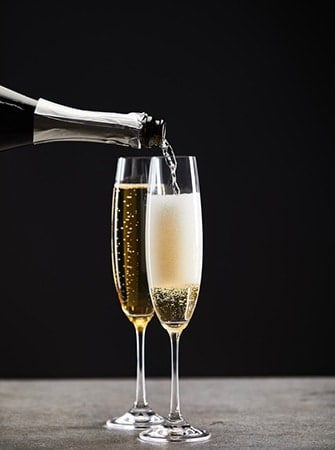
Tasting notes
Champagne tasting notes differ between champagnes, but there are common flavors and notes you can expect depending on the dryness.
The flavor of an Extra Brut, or dry Champagne, is bready, with a crisp, citrusy profile. The flavor of an Extra Sec, or sweet Champagne, is fruity and sugary, with peach that flows to a creamy or brioche-like taste.
If you like a balance of sweetness and acidity in wine, you want Brut champagne. Look at Semi-Sec and Doux champagnes for dessert champagne, which often taste like candied fruit and caramel with a chalky minerality.
Grape variety, production processes, and the vintage (the year the grapes are harvested) determine the Champagne's flavor profile.
Regarding the vintage, seasonal differences, including rain volume, sunlight, and temperature, affect the flavor of the grapes. Additionally, the month the grapes are picked plays an important role in the juice's tartness.
Related: How long does Champagne keep for?
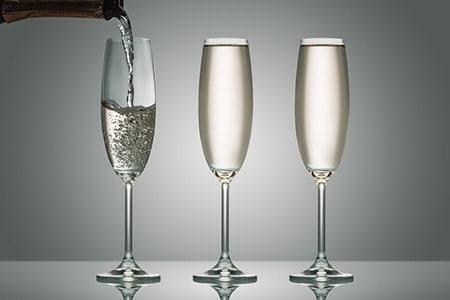
Food pairings
The great thing about Champagne is you can pair it with any food because it's available in extra dry and extra sweet varieties.
However, it is best with smaller bites due to the intense carbonation.
Here are some of our favorite pairings:
- Blanc de Blancs – fresh seafood and fatty foods like soft cheeses
- Dry Champagne – savory pastries and hard cheeses
- Balanced Champagne – pasta in white sauce, chicken dishes
- Sweet champagne – cakes, sweet pastries, chocolate, candied fruit
Age
Non-vintage Champagne must spend at least fifteen months in the bottle before it is released, with 12-months designated for maturation.
Vintage cuvees - champagnes made from the first pressing with the freshest juice – require a minimum of three years in the bottle.
While some vintage champagnes spend five years or more maturing, aging beyond five years does not always produce a superior product.
Importantly, Champagne can age gracefully on the wine rack, but after corking, it can lose bubbles over time, which will reduce the quality of the Champagne.
Background of Prosecco
Learn all about Prosecco wine now as we take a deeper dive into its back story.

Summary
Just as France has a Champagne region, Italy has a designated Prosecco region.
Wine from the region has been called "Prosecco" for centuries, but Prosecco as we know it uses the Charmat method, which was invented at the turn of the twentieth century.
History
Prosecco gets its name from the Northern Italian region of Prosecco, documented by the Romans as far back as 200 BC as "Puccino."
The first documented mention of "Prosecco" is in a poem written in 1754 by Aureliano Acanti.
Although the region of Prosecco gives Prosecco wine its name, the heartland is the smaller region of Veneto, Conegliano Valdobbiadene, with documents linking Glera vineyards to the region in 1772.
Wine from this region has been called "Prosecco" for more than four hundred years, with the earliest wines using the ancestral method (single fermentation) -- the same method used to produce early champagnes.
At the turn of the twentieth century, Inventor and chemist Federico Martinotti developed the Martinotti method, which introduced second fermentation in stainless steel containers under pressure, greatly simplifying production.
The wine is filtered and bottled at the end of the second fermentation. Martinotti's method allowed winemakers to increase production volumes and reduce time.
Related: How does Prosecco compare to the similar sparkling white wine Moscato?

A few years later, Eugene Charmat, a French agricultural engineer, improved Martinotti's method with the Charmat method, which uses specially designed autoclaves (tanks). These tanks are still used in the production of Prosecco today.
Despite this heritage, Prosecco wine was relatively unknown outside Italy at the turn of the twenty-first century. As the quality of Prosecco wine increased, so did demand, with the first bottles imported into the mainstream US market in 2000.
In 2009, Prosecco grapes were renamed Glera grapes as part of the creation of the Prosecco DOC, which greatly expanded Prosecco's production zone. Today, the Prosecco DOC spans 35,000 acres from Veneto to Friuli-Venezia-Giulia.
Prosecco has appellations according to where the grapes are grown. For example, wine from the classic production zone is labeled DOCG, wine from newer zones is labeled DOC, and wine from Cartizze is called Superiore di Cartizze.
Prosecco's late introduction to the US market means it is less well-known than Champagne, but the lower price point makes it a popular choice.
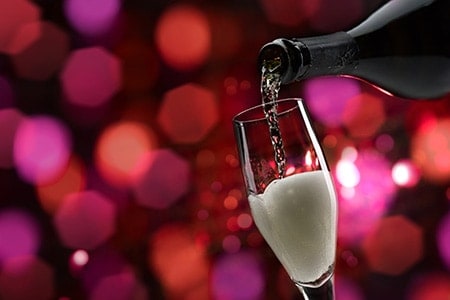
How it's made
Prosecco is made from at least 85% Glera grapes, and most Prosecco is produced using the Charmat method. Here are the stages involved:
Harvesting
Glera grapes are picked in Northern Italy in the Prosecco DOC. The juiciest, ripest grapes are grown on hillsides, hand-picked because machinery can't operate there.
Pressing
The grapes are lightly pressed to limit contact of the juice with the skins, and the must is then filtered and clarified, ready for fermentation.
Vinification
The clarified wine enters a large stainless-steel vat with natural yeasts to produce the first alcoholic fermentation.
It stays in the vat for several weeks, producing the "base" wine, which is taste-tested to evaluate the quality.
Second fermentation
The base wine is added to pressurized Charmat stainless steel autoclaves with a mixture of sugar and special yeasts, with the second fermentation taking up to six months. When the first bubbles appear, the wine develops its final flavor.
This stage gives Prosecco its bubbles; the yeast consumes the sugar and turns it into carbon dioxide and alcohol, producing a final raw product.
Dead yeast removal
After the second fermentation, dead yeast from the wine is removed by rapidly cooling the wine and filtering it into another tank, which removes the dead yeast cells.
Bottling
Once clarified of dead yeast, the Prosecco wine is bottled. The bottling stage is just as important as the fermentation stages, for the ambient temperature of the bottling plant can ruin the flavor profile and carbonation quality.
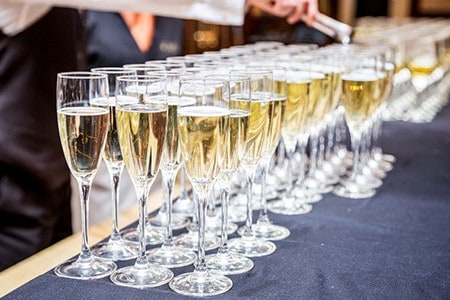
Tasting notes
Prosecco is available dry (Brut) or sweet (Sec) – confusingly, Sec means dry, but it is noticeably sweet - sparkling wine. Still, in any case, it usually tastes sweeter than the equivalent Champagne because of the Glera grapes' fruitiness.
Most Prosecco wines are in the extra dry style, and these have zingy citrus or lemongrass flavors with a hint of melon. A bottle of dry Prosecco has flavors of citrus, green apple, and white peach with a hint of honeydew.
Sweeter Prosecco varieties have a stronger honeydew flavor with notes of apple, pear, peach, apricot, and hints of candied fruit.
The most popular Prosecco variety is brut because it balances acidity and sweetness, giving the wine a satisfying, refreshing profile.
Food pairings
Dry Prosecco is best with savory cheeses and cured meats, while sweet Prosecco varieties are best with cakes and other sweet treats.
Prosecco also makes a suitable aperitif for seafood, shellfish, chicken dishes, risotto, and pasta with white sauce. Brut Prosecco is nice with Asian cuisine, including Thai noodles and sushi as a sweet and salty appetizer.
Smoked fish and smoked cheeses are particularly nice with Prosecco, with the crispness and bubbles helping refresh the palate after every bite.
If you'd like to go into more detail on Prosecco food pairings then don't miss our guide.
Age
The crispness of Prosecco is meant to be enjoyed when the wine is as young as possible, with peak fermentation occurring within a year.
Most Prosecco goes from harvest to bottle within 12-months, and the 'vintage' or 'Millesimato' on the bottle refers to the harvest year.
Unlike Champagne, Prosecco does not mature well with age because it has a higher sugar-to-acid ratio than Champagne, which makes it go off faster, losing its crispness and bubbles after a few years on the shelf.
Prosecco is one of the few sparkling white wines you can drink the year after the grapes were harvested because of its fast production.
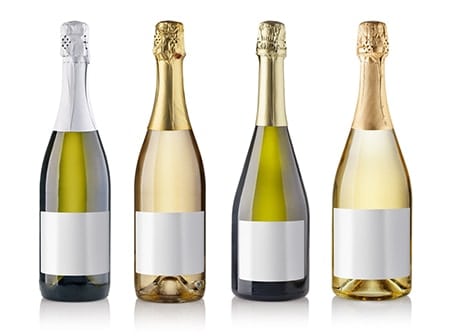
A Comparison: Prosecco vs Champagne
Prosecco and Champagne are sparkling white wines, but they come from different countries, use different grapes, and follow different production processes.
The result is two distinct wines with very different profiles.
How they're made
Champagne and Prosecco undergo two stages of fermentation, but the key difference is how the second fermentation stage is performed.
With Champagne, the second fermentation happens inside the bottle, while with Prosecco, the second fermentation happens inside a pressurized autoclave.
Champagne takes longer to make than Prosecco and ages gracefully, while Prosecco is best when it is young, with the pressurized tank speeding up fermentation.
Prosecco is made with at least 85% Glera grapes and 15% other varieties, while Champagne is made with three varieties – Chardonnay, Pinot Noir, and Pinot Meunier.
With pink wines, Pinot Noir and Pinot Meunier grapes are pressed with red skins to give the wine its pink color. With white champagnes that use red grapes, the pressing is light to ensure the skins do not bleed any color into the juice.
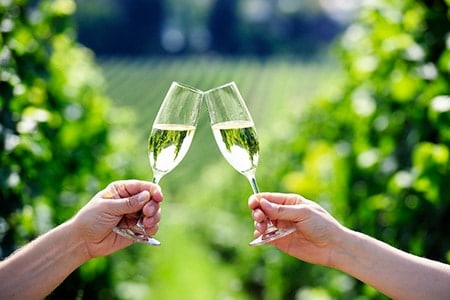
Tasting notes
Citrus, peach, almond, and toast are the hallmark of young champagnes, with vintage varieties having intense bready and almondy notes.
Blended champagnes have a complex nose with notes of melon, plum, and caramel, with fruitier notes prevalent in varieties heavy with Pinot Noir.
Prosecco's primary flavors are crisp green apple, honeydew, honeysuckle, pear, and light cream, and the profile is much more fruit-forward. Sweet Prosecco tastes like a dessert on its own, with a candied fruit finish.
In terms of fizziness, Champagne is fizzier, with finer bubbles and more carbonation, but some people prefer the larger bubbles in Prosecco.
Food pairings
Champagne goes well with oysters, lobster, caviar, pasta in white sauce, fatty cheeses, bread, and savory dishes.
The dryer the Champagne, the better it is with seafood. Blanc de Blancs is a natural pairing with seafood because of its clean, citrusy flavor.
With cheese, pasta, and savory foods, venture into Pinot Noir champagnes, which have a richer profile to cut through heavy flavors.
Prosecco is fruitier and sweeter than Champagne, so it lends itself best to smoked dishes like cured meats, smoked cheeses, and barbequed food.
A dry Prosecco pairs perfectly with seafood, shellfish, and chicken dishes. The best combination is dry Prosecco with traditional pasta dishes like Carbonara, where the fruity Prosecco balances the salty Pecorino cheese.
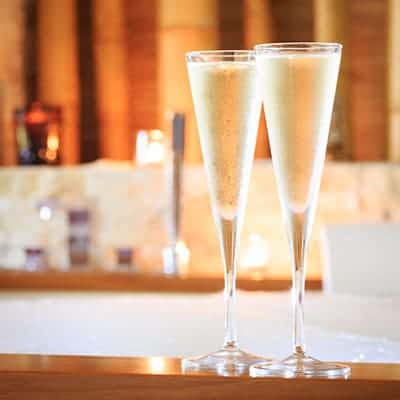
Price
A bottle of the finest Champagne costs more than the finest bottle of Prosecco because it takes longer and incurs more cost to produce.
While a bottle of entry-level Champagne starts at around $40, a bottle of entry-level Prosecco starts at around $12 (give or take a few dollars).
As we climb the luxury scale, Champagne gets very expensive. You can easily spend $10,000 on a prized vintage produced in limited quantities.
Varieties
There is a lot of terminology involved with wine and these popular sparkling wines are no different. Here's what to look out for:
Champagne
- Non-vintage – white, blended, up to three grapes (Chardonnay, Pinot Noir, Pinot Meunier)
- Vintage – made with grapes from only one year's harvest
- Blanc de Blancs – 100% Chardonnay (white)
- Blanc de Noirs - Black grapes (Pinot Noir, Pinot Meunier) – almondy color
- Rosé – pink, color from the red skins of Pinot Noir and Pinot Meunier
- Prestige Cuvee - made from the first grape pressing with the freshest juice
Prosecco
- Prosecco Spumante – sparkling
- Prosecco Frizzante – semi-sparkling
- Prosecco Tranquillo – still
- Prosecco DOC (grapes from areas of the Prosecco region)
- Prosecco DOCG (grapes from the famous hilly regions of Prosecco – higher quality)
- Prosecco Cartizze (grapes from the tony parcel of Cartizze - highly prized)
Dry varieties
- Brut Nature – bone dry
- Extra Brut – dry
- Brut – dry with a hint of sweetness
Sweet varieties
- Extra Dry – balanced sweetness
- Dry – noticeably sweeter
- Demi-Sec – sweet for desserts
- Doux – sweet enough as a dessert itself
Brut is the sweetest dry designation for sparkling wine, while Extra Dry is the driest designation for sweet wines.
Confusion over Extra Dry being sweeter than Brut can lead to buying the wrong bottle, so always double-check.
Dryer sparkling wines are best with savory dishes, while sweeter wines are better with desserts. For cheeses, you want a Brut or Extra Brut.
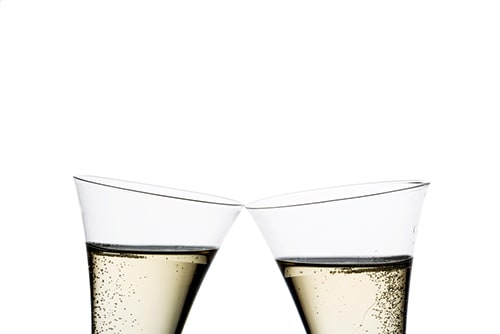
Alcohol content
Most Prosecco has an alcohol content of 12% to 12.5%, while most Champagne has an alcohol content of 12.5% to 13.5%. So, overall, Champagne is slightly more alcoholic than Prosecco, but not by a significant margin.
In terms of calories, Prosecco and Champagne are nearly identical. There are approximately 86 calories in a 125ml glass of Prosecco or Champagne.
Age
Prosecco is a younger wine than Champagne, harvested and bottled in one year. Champagne is produced over at least fifteen months, and vintage varieties are bottled for over three years before being put on sale.
Champagne has the advantage of maturing and developing flavor after being bottled, with a typical shelf life of five to ten years for vintage bottles.
Prosecco doesn't age very well and lasts around two years unopened. It has a higher sugar content, so the crisp flavors degrade faster over time.
Drinking a bottle of Prosecco after two or three years won't be unpleasant, but it be less fresh with fewer bubbles, and in some cases, it will be flat. Champagne preserves its taste better, delivering full flavor after years on the shelf.
Conclusion
Is Prosecco the same as Champagne? Not at all. Here are the fundamental differences:
- Champagne is from France; Prosecco is from Italy.
- Champagne can only be produced in the Champagne district in France; Prosecco can only be made with grapes from the Prosecco DOC.
- Champagne is made from Chardonnay, Pinot Noir, and Pinot Meunier grapes; Prosecco is made from 85% Glera grapes.
- Champagne has a citrusy, almondy, and bready taste and smell; Prosecco is fruitier and sweeter, with a heavy note of green apple.
- Champagne has finer bubbles than Prosecco.
- Champagne is produced with a longer second fermentation in the bottle; Prosecco has a shorter second fermentation in a tank.
- Champagne is always fizzy; Prosecco is also available in semi-fizzy and still varieties.
- Champagne is aged and continues aging gracefully in the bottle; Prosecco is a new wine, best when it is fresh, with a shorter shelf life.
- Champagne is highly prized and more expensive on average than Prosecco, which is cheaper and more accessible.
Overall, both Champagne and Prosecco have a place in your wine rack. While Prosecco is beautiful anytime, Champagne brings something special to parties and events. You can't go wrong with a fine bottle/vintage of either.

Thank you for explaining how prosecco is a fruitier and sweeter drink than champagne. My sister is thinking about drinks that she wants at her Christmas and New Year's parties this year. She mentioned prosecco as one of her choices, so I was curious to learn more about it, since I usually drink champagne.